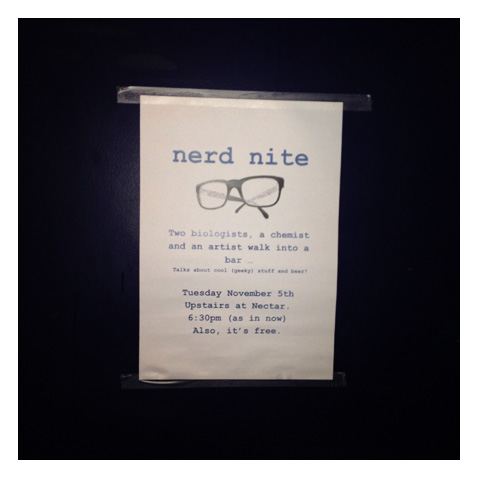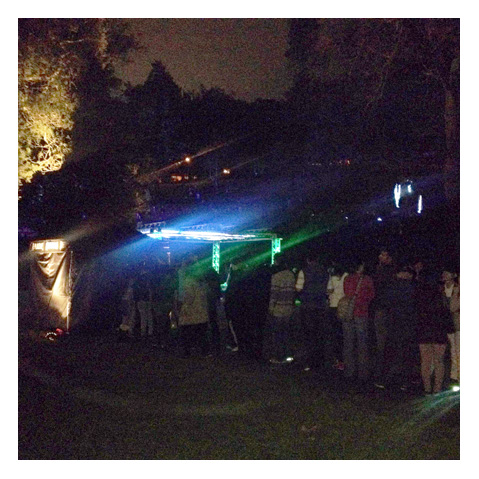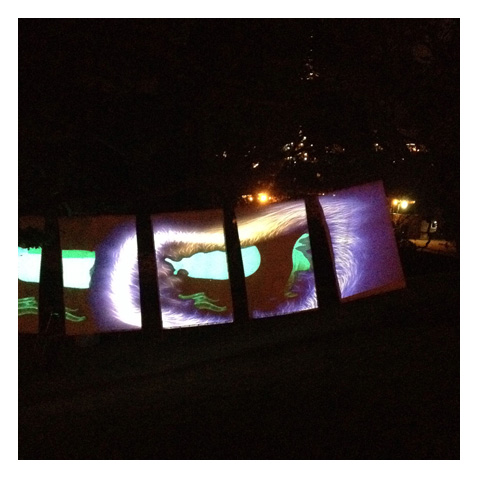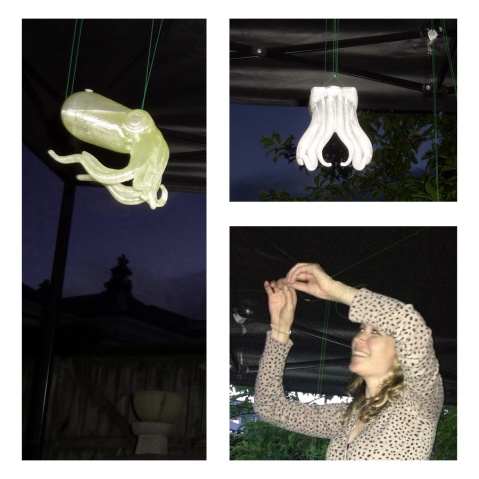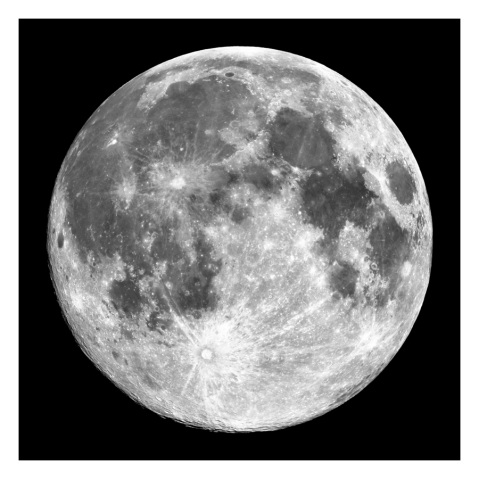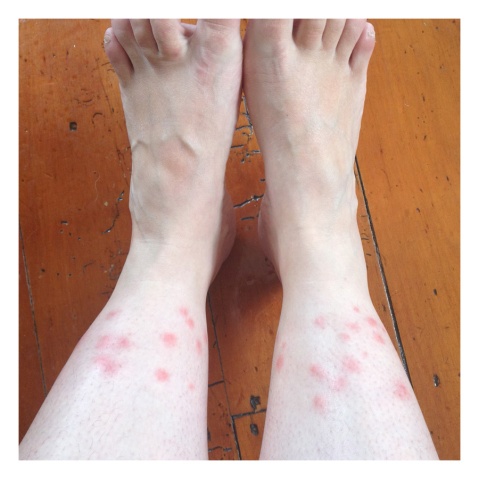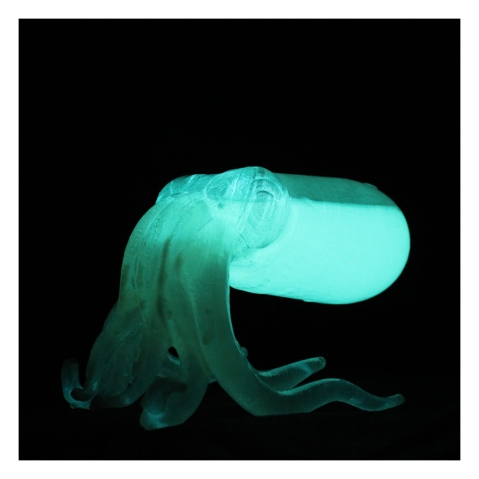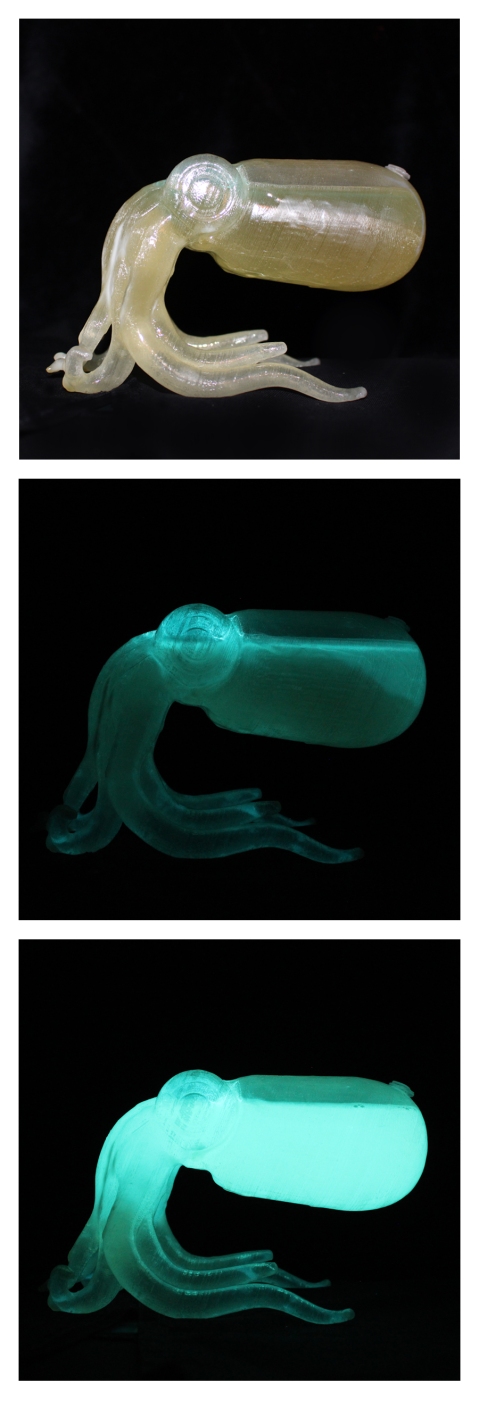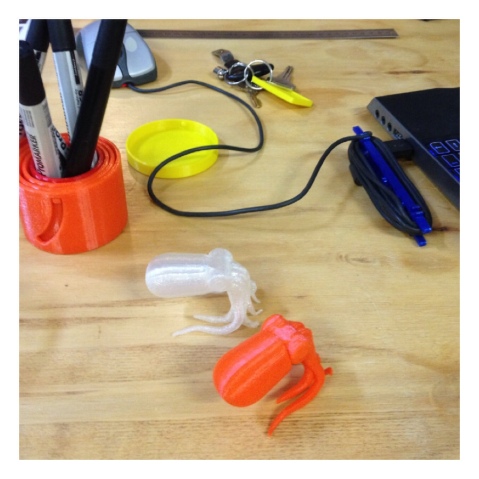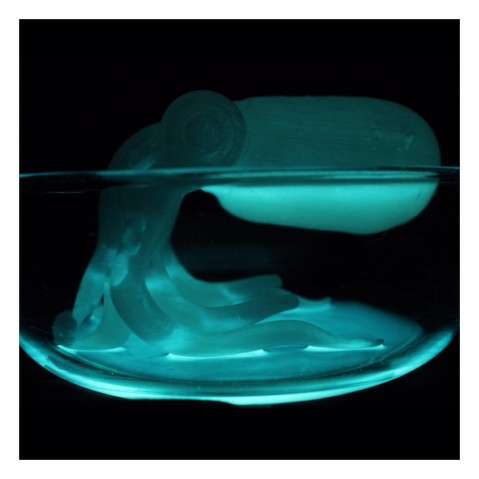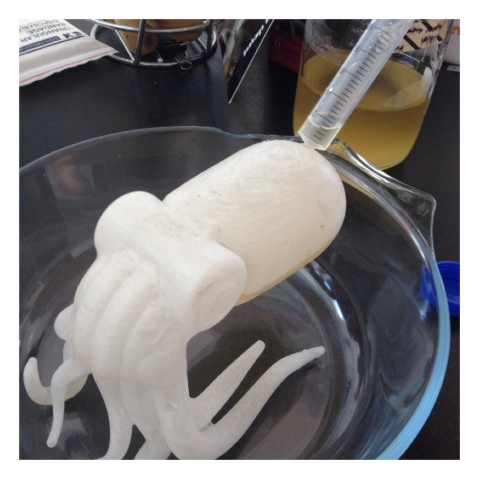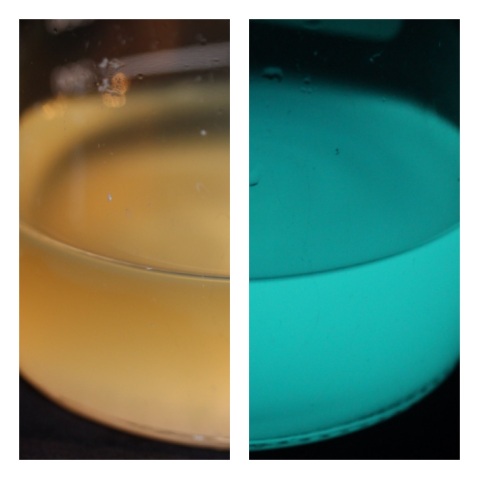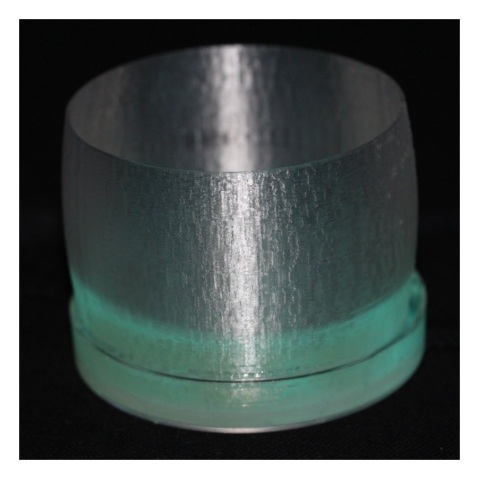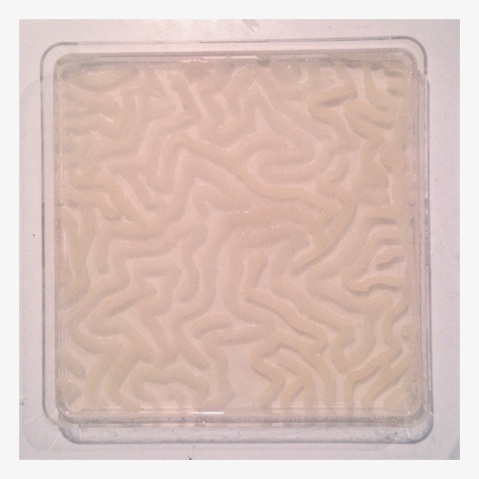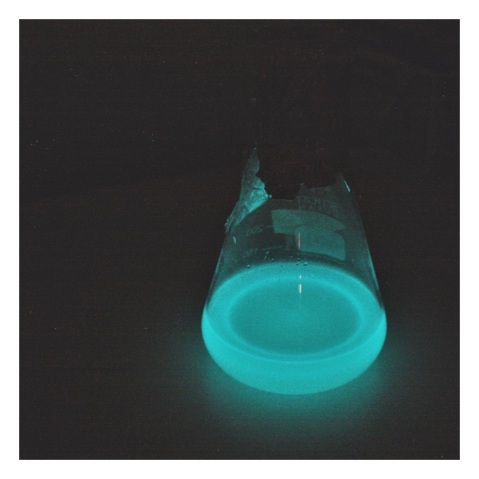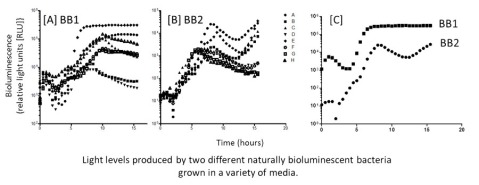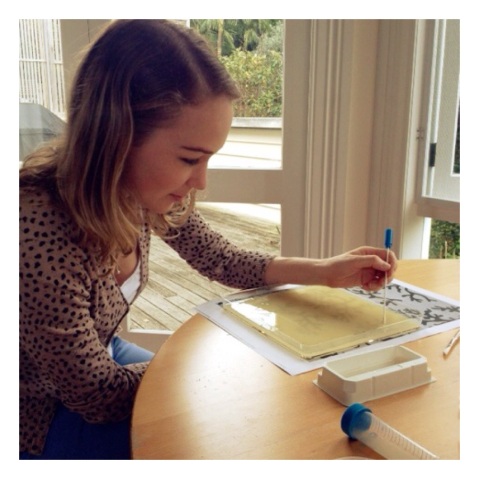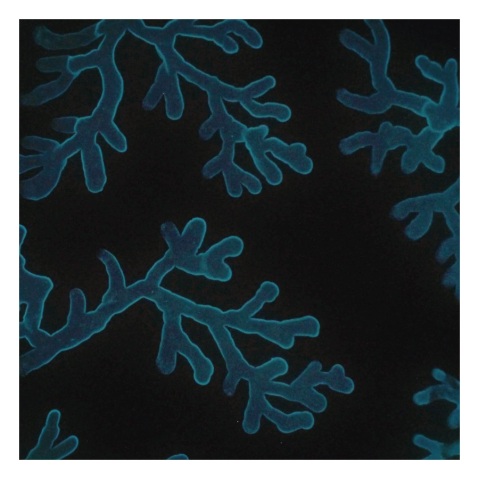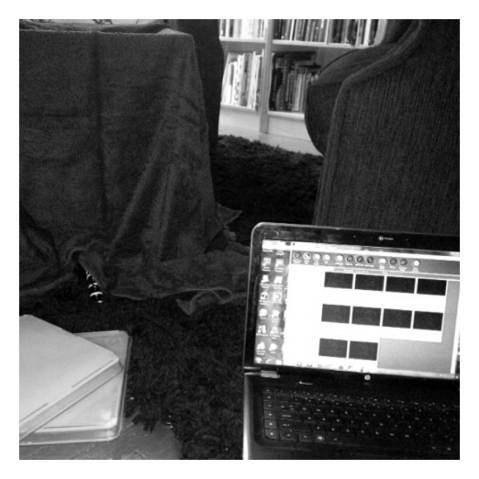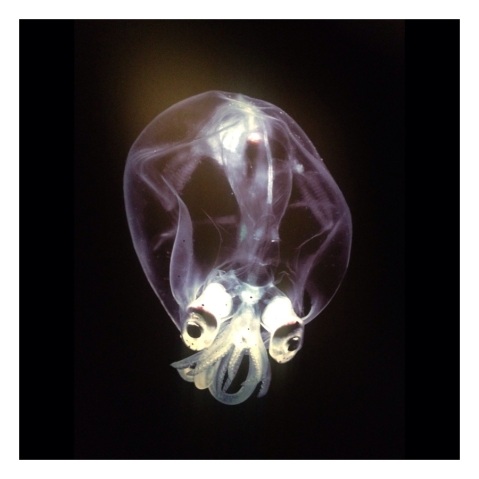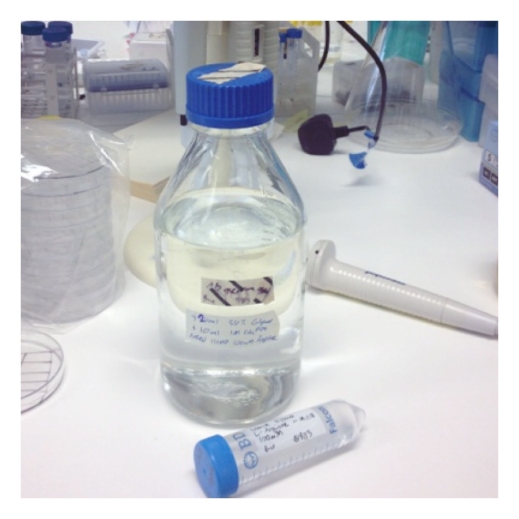Week 15
Rebecca says:
What happened this week?
This week was the final countdown to Art in the Dark. I put in some late nights to seal up the rest of the squid and finish the other elements of the installation.
Siouxsie and I also presented the project at Nerdnite, a monthly event that takes place on the first Tuesday of every month, featuring “beer and interesting stuff to listen to a talk about”. We presented along with scientists Heather Hendrickson and Peter Schwerdtfeger to a crowd of 60-odd, which was apparently the best turn out that the event had had so far.
Art in the Dark was meant to kick off on Thursday 7 November, but heavy downpours earlier in the day meant that the event was called off for that evening. The park was a boggy mess, so it was the right decision, but the disappointment was shared by the organisers, participating artists and the public alike. We were particularly heartbroken as we hadn’t seen the email calling off the event until after we’d filled and sealed up the squid with the bacteria solution for that evening. We had a set of beautifully glowing squid and no one to show them to!
Fortunately the weather cleared for Friday and fined up further on Saturday, so Art in the Dark went ahead on these evenings and our squid had their first public exposure. The response was even better than I had expected, with numerous positive comments about the installation. On Saturday, we had queues of over 100 people at a time lining up to see it!
Siouxsie did a fabulous job of sharing the story of the curious relationship between the bioluminescent bacteria and the squid, and relating this back to her area of research. She kept people engaged, despite the considerable amount of time that they had been waiting to see the work. I stepped in to give her a hand where I could.
What did you learn?
I certainly gained an appreciation of the amount of work that goes into putting on this amazing event. Hats off to the Art in the Dark team!
I also learnt a lot more about bacteria thanks to Heather’s Nerdnite presentation – that imbalances in good gut bacteria could be causing (or be caused by) obesity and that this can potentially be rectified by faecal transplants, hmm…
What are you most inspired by/excited about?
It was so inspiring that so many people were so keen to see, touch and learn about our installation . It certainly made all the hard work worthwhile.
What’s next?
We’ve been talking a bit about what’s next, as both of us are keen to explore further collaboration. We’ve also received several comments that people would have liked to see Living Light, but they couldn’t make it to Art in the Dark, couldn’t find us at the event or couldn’t be bothered queueing to see it (!), so we’re looking into opportunities to show it again.
Siouxsie says:
What happened this week?
This week was the one we’ve all been waiting for – Art in the Dark. Finally we got to see our Living Light installation in all its glory. Torrential rain in Auckland meant the first night was cancelled which was a big disappointment, but definitely the right decision for the organisors to make. The ground was absolutely soaking – we even had a couple of huge puddles near our tent that the ducks had taken a shine to.
Opening night on Friday went really well, although our installation was dwarfed by the gigantic light show next to us, so I heard that a few people missed our little tent. But those that did find us all said they loved our piece, which was great to hear. We spent Saturday making a sign to make our tent a little more visible – it certainly worked and we had a queue of people patiently waiting to come and see the squid.
One of the things I found most stressful about our project was our reliance on a living organism to bring our installation to life – without the bacteria glowing, we would have a tent full of (very beautiful) 3D printed squid that no one could see. But fortunately the little critters (all 10 trillion of them…) behaved as expected and were glowing beautifully by the time people started to come around. Phew!
I’d like to extend a huge thanks to everyone who has been involved in this project. It may have said Rebecca Klee and Siouxsie Wiles on the signage, but Living Light wouldn’t have happened without the hard work put in by Danny of Vivenda (designing and printing the squid) and Benedict and Jimmy from my lab (preparing all the media and bacterial cultures when needed). It also wouldn’t have been possible without the generous financial support of the Faculty of Medical and Health Sciences at the University of Auckland (thanks to Tim Greene and Katie Elliot) and the Maurice Wilkins Centre for Molecular Biodiscovery. And finally I would like to thank my husband Steven and daughter Eve for their tolerance of the time this project has taken me away from them, and for putting up with all the bacteria growing in our kitchen!
What did you learn?
That Art in the Dark doesn’t happen without the tireless work of a fantastic team behind the scenes. Thanks everyone for bringing this amazing event to life!
What are you most inspired by/excited about?
It was so exciting to see our installation come together after so much planning and hard work. It was also brilliant to see people reacting so positively to it. It makes all the hard work worthwhile!
What’s next?
That’s a good question! Rebecca and I are very keen to show Living Light again so, when the dust has settled, we will look into how and where we could do that. We are also keen to collaborate again so I’m sure we will be putting in an application for Art in the Dark next year.
Week 13
Rebecca says:
What happened this week?
Now that we had got the squid glowing nicely, we were keen to see how they would look assembled together. We decided to do a trial run in my backyard, so hired a pop-up canopy for the evening and set it up with the squid that I had already prepared.
There’s still a few elements of the installation to finish off, but the trial gave us a great indication of how it should look on the night.
What did you learn?
The trial run was a great opportunity to check measurements and tweak different aspects of the installation. I definitely learnt a lot from the process.
What are you most inspired by/excited about?
I’d like to say that I’m excited about picking up the rest of the printed squid, but I anticipate that they’re going to take over my life from here on in!
What’s next?
I’m picking up a giant digital fabric print of the moon from AUT’s Textile and Design Lab next week. Wait to see what we’re doing with that!
Siouxsie says:
What happened this week?
Last week Rebecca and I had a trial run, setting up five of the glowing squid in a tent in her back garden. Fortunately all the bacteria behaved and were glowing beautifully. It was great to get a feel for what our piece is going to look like.
What did you learn?
That Rebecca’s garden is full of mosquitoes! I picked up 75 bites in the two hours we were setting everything up.
What are you most inspired by/excited about?
I can’t wait for the event and seeing what everyone thinks of our project.
What’s next?
On the bacteria side, we are just preparing the litres and litres of growth media we will need to fill all the squid each night of the festival.
Week 11
Rebecca says:
What happened this week?
We’ve had a break from the blog over the past two weeks, as I’ve been working with Danny to stop the 3D printed squids from leaking. We finally cracked it – a low-tech solution of coating the models with layers of PVA and then polyurethane. I’ve done a couple rounds of testing, and they all seem to be holding well.
On Thursday, we finally got to see the sealed up squid with bacteria in action. They’re looking amazing!
What did you learn?
It’s definitely been quite a learning curve working with these new materials and techniques. Similar to other creative projects that I have worked on, you never quite know what you are going to end up with, until you get stuck in and give something a go.
What are you most inspired by/excited about?
I can’t wait to see and hear other people’s reactions to the project once the installation is in place. We’re pretty excited about our glowing squid, and we hope others will be too!
What’s next?
Next up is printing the twenty-odd squid and starting the production line to seal them all up. My workspace is going to be overrun by squid for the next week or so!
Following that is finalising the last structural elements of the installation. Just over three weeks to go now!
Siouxsie says:
What happened this week?
It’s been a quiet few weeks on the lab front while I waited for the little squid to be made leak-proof. After several attempts it looks like Rebecca and Danny have cracked it and today Rebecca brought around a couple of models for us to play with. They look absolutely fantastic filled with the glowing bacteria.
What did you learn?
That it is possible to make a leak-proof 3D printed squid. Phew!
What are you most inspired by/excited about?
If I’m this excited at seeing two glowing squid, I can’t imagine what I’m going to be like when we have about twenty of them!
What’s next?
Now we know it’s all going to work, we need to decide how many squid to have in the piece and get them printed and made water tight. Meanwhile, back in the lab we’ll start making up all the twenty or so litres of media we are going to need to grow the bacteria in.
Week 8
Rebecca says:
What happened this week?
This week was exciting as we had some prints of the squid made up by Danny at Vivenda, and they look very cool!
The models are based on the Hawaiian bobtail squid, which forms a symbiotic relationship with the bioluminescent bacteria that we’re using to create light.
What did you learn?
The squid look great, but they’re not watertight, which is not ideal for containing a solution of bacteria. I looked into some options for sealing the outer surface of the models – this even included visiting a boating specialist supplier.
What are you most inspired by/excited about?
After seeing the photo of the (albeit leaky) glowing squid, I’m particularly motivated to find a way to make it work in this form.
What’s next?
We’ve got a few ideas for getting around the leakiness, so now it’s just a matter of experimenting with these ideas. We also set up the time-lapse video to run again this weekend, so all going well we’ll have a video to show next week.
Siouxsie says:
What happened this week?
This week Rebecca brought round some 3D printed squid prototypes that Danny made for us. She had tried to make them watertight so we could see how well the bacteria looked inside them. Unfortunately, several layers of sealant later and they still leaked. But they still looked amazing when filled!
What did you learn?
That the squid will look amazing if we can get them leak proof.
What are you most inspired by/excited about?
Even though the prototype models are leaky, I can’t help but be excited about how the project is coming together. Rebecca and I had a bit of a brain storm and had plenty of ideas for things to try to resolve the problem. It feels like just a minor set back.
What’s next?
Rebecca and Danny are going to try sort out the leaky models. All I can do now is wait.
Week 7
Rebecca says:
What happened this week?
We tested the brightness of the bacteria solution through the 3D printed vessels, and it looks great!
What did you learn?
I was amazed that the petri dishes that I painted up last week were still glowing this weekend. For the moment, we’re assuming that the bacteria will glow for a day or so. If we find that the culture actually lights up for a longer period of time, perhaps this could save us having to replace it each evening of the event?
What are you most inspired by/excited about?
It’s been satisfying answering some of the key questions that we’ve had since the start of the project – now we know we’re on track to achieve what we’ve got in mind.
What’s next?
The next step is to start getting some models made up. It’s probably going to be a bit of trial and error to get the design to look and work how we imagine, but I can’t wait to get started!
Siouxsie says:
What happened this week?
This week Rebecca had some little cups 3D printed for us, so we met at the lab to make sure the glow of the bacteria can be seen through the material. And they can, which didn’t come as a huge surprise given that light can travel through flesh and skin – just trying putting your hand over the top of a torch! I also had another go at the time-lapse photography and finally captured the bacteria starting to glow.
What did you learn?
That the little 3D printed cups weren’t leak proof!
What are you most inspired by/excited about?
It really feels like we are making progress! I can’t wait to see how the 3D printed models come out.
What’s next?
Finalising the vessels to show the glowing bacteria off in.
Week 6
Rebecca says:
What happened this week?
This week I had some simple models made up using a 3D printer, so that we can check the luminosity of the bacterial solution through the printed material. Thank you to Danny at Vivenda 3D printing for whipping these up so quickly!
I also experimented with some other petri dish painting techniques and designs, which produced some interesting results. Here’s one of the designs with the lights on:
What did you learn?
The watertightness of 3D printed models can be variable depending on the design and density of the print. We certainly don’t want bacteria leaking out from whatever receptacle we choose, so we’ll need to find some way to overcome this.
What are you most inspired by/excited about?
3D printing is a pretty exciting process to experiment with. You can see results very quickly and the possibilities really are endless.
What’s next?
More models, mark-making, time-lapse photography and experimentation ahead!
Siouxsie says:
What happened this week?
This week I picked up an AC adapter for my camera and tried out the time-lapse photography again. For some reason though the bacteria weren’t growing very brightly, which was a shame so I’m going to have to try that again.
I also tried growing the brightest bacteria from last week (BB1) in a larger volume of media E to see if the 300,000 relative light units measured by our luminometer is enough to see by eye. And it is, yay!
What did you learn?
That my eyes can see 300,000 relative units just fine!
What are you most inspired by/excited about?
I’m so excited that we’ve found good conditions for growing the bacteria so they glow, and that the light is bright enough to see by eye. Now we just have to work on what we are going to be putting the bacteria into.
What’s next?
I’m going to try the time-lapse again, but really we now need to be focusing on what some of receptacle we will be using to contain the bacteria for our piece.
Week 5
Rebecca says:
What happened this week?
This week was a bit quieter on my side, as it was all happening in the lab!
What did you learn?
Unfortunately our original model making plan fell through. I’ll be on the hunt for alternatives this week.
What are you most inspired by/excited about?
Our artist profile is now live on the Art in the Dark website! We’re up there with a number of other artists doing some very cool looking projects – definitely take a moment to check them out.
What’s next?
Siouxsie is picking up an AC power pack so that we can re-run the time-lapse without having to worry about the battery running out.
We’ll hopefully be able to show you a video by next week!
Siouxsie says:
What happened this week?
This week I’ve been processing all the images taken from the time-lapse photography and turning them into a movie. It was a little disappointing to be honest, as I somehow managed to knock the focus and so for half the movie the pictures were all fuzzy. Very frustrating!
I’ve also analysed the data from the experiment that my postdoc Jimmy set up. We tried growing two different naturally bioluminescent bacteria in eight different growth media. Interestingly they preferred different conditions to grow in and expressed their light a little differently.
Looking at graph A, the brightest signal for Bioluminescent Bacteria 1 (BB1) was after growing in media E and it reached its peak glow after 8 hours. However, in graph B we can see that BB2 prefers media A. When we compare these two in graph C, we can see that BB1 is more than 10x brighter than BB2 and that it reaches its peak faster and stays at its peak for longer.
What did you learn?
That making a time-lapse movie is hard work and will take some practise to get right.
What are you most inspired by/excited about?
Now that we’ve found a couple of good conditions for growing the bacteria, I’m keen to try them on a larger scale and see just how bright they will be.
What’s next?
This week I’ll be trying the time-lapse photography again, as well as repeating the growth experiments to see how bright 300,000 relative light units actually is to the human eye!
Week 4
Rebecca says:
What happened this week?
I tried ‘painting’ with bacteria! It’s not straightforward because you can’t really see anything until it grows – just a slight sheen on the already shiny agar plate. I think the design has turned out pretty well for a first attempt in any case.
Other things that I have been up to this week include chasing up some model making ideas and sorting out gear for the time-lapse video that we ran today.
What did you learn?
It’s been quite a learning curve figuring out how to do the time-lapse video. It is the first time that either Siouxsie or I have attempted to do one, and we’re working with a less-than-easy subject matter!
What are you most inspired by/excited about?
I’m excited to see the results of the time-lapse video!
What’s next?
I hope that next week I can make some progress sorting out the models that we have in mind. We’ll also hopefully hear that results of the experiments that Siouxsie’s lab have been running, as this will influence the direction that we take from here.
Siouxsie says:
What happened this week?
This week I got the whole of my lab to help with making all the different kinds of media that we want to test the bacteria growing in, and pouring agar plates. Hopefully I’ll be able to report what media they liked in next week’s update.
Rebecca came along to my place and I showed her how to ‘draw’ a design onto an agar plate with the bacterial solution. She tried a couple of really beautiful designs almost remeniscent of coral, while I had a try tracing over a QR code for our website.
I just left the agar plates in my living room over night to see if they would grow at room temperature but as it’s August, and I live in an unheated, uninsulated villa, there was just the faintest trace of bacteria in the morning. I usually grow the bacteria in an incubator set at a balmy 28 degrees Celcius, so it’s not wonder they were a little slow off the mark!
We also decided to experiment with doing some time-lapse photography of the bacteria growing on the agar plates, so I’ve been reading camera manuals and figuring out how to run the programme on the computer to control the camera remotely.
One thing about time-lapse photography though is the need for a good power supply for the camera. Rebecca checked out equipment hire places to try to get an adapter to plug our camera into the mains, but to no avail, so we are reliant on changing and recharging the battery every eight hours… I also set up a makeshift ‘darkroom’ in my house to take the photos – now the challenge is keeping my two cats from interfering with it!
What did you learn?
How to do time-lapse photography and remotely control my camera. Rebecca also sent me a link to learn how to batch process the photos in Photoshop which should save a lot of time.
What are you most inspired by/excited about?
I can’t wait to see how the movie comes out when we put all the photos together.
What’s next?
This week we will be editing the hundreds of photos we took and putting them together to make a short movie, hopefully of a glowing pattern emerging!
Week 3
Rebecca says:
What happened this week?
I met Siouxsie at her lab to check out how the bacteria were glowing in solution. Unfortunately they were not cooperating and were barely glowing at all. Siouxsie will experiment with some different media to see if she can get them glowing better for next week.
After I left the lab, I went to meet my sister at Auckland Museum, where she works. We wandered around the exhibition Moana – My Ocean for some underwater inspiration. It was fun to explore the augmented reality specimens and experience being in the middle of a Hauraki Gulf boil up, or fish feeding frenzy. I also met some distant relatives of the bobtail squid, such as this alien-looking glass squid.
What did you learn?
This week did remind me that we are dealing with a somewhat unpredictable subject matter!
After attending Moana – My Ocean, I also watched the exhibition’s behind the scenes videos. Although it’s not directly related to our project, I enjoyed learning about all the work that goes into each element of an exhibition like that.
What are you most inspired by/excited about?
I can’t wait to see the final installation, but I’m also excited about documenting the process of how we get there. We’re actually working on an idea for a ‘behind the scenes’ video ourselves.
What’s next?
We’re getting closer to deciding on the final form to contain the bacteria, though we’re going to need some help in seeing this come to life. That’s what I’m working on this week.
Siouxsie says:
What happened this week?
Rebecca and I met for a catch up at my lab. I had hoped to have beautiful glowing bacteria to show her but they weren’t particularly bright. We had another chat about ideas for how to contain the bacteria.
What did you learn?
That bacteria don’t always do what you want them to do, but then as a microbiologist, I’m very familiar with this concept!
What are you most inspired by/excited about?
Same as last week, still excited by everything!
What’s next?
This coming week we are going to try a range of different types of media to see which our bacteria prefer to grow and glow in. We are going to set these experiments up overnight in a luminometer, a machine which measures light, so that we can take lots of measurements over time and see when the bacteria start to glow.


